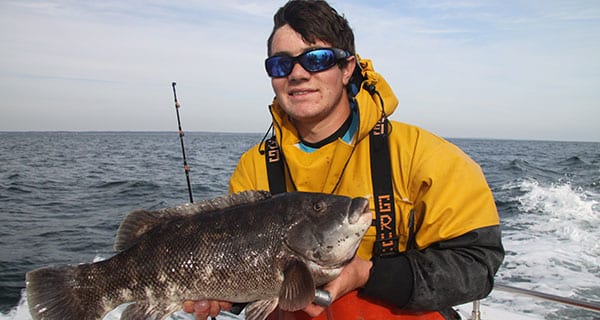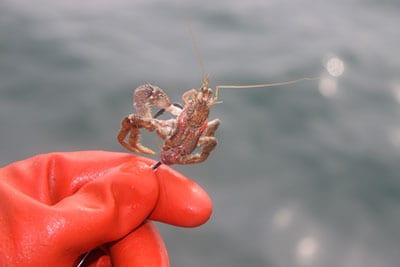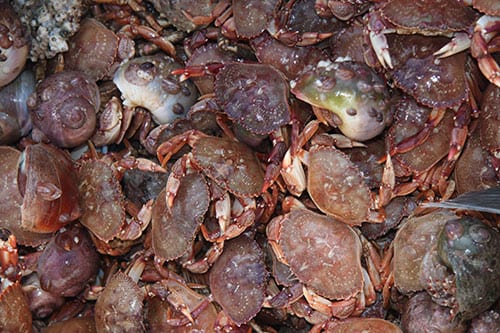
By Tom Schlichter
It’s amazing how quickly the fishing can change in the waters of Long Island Sound on up into Southern New England ad November’s page appears on the calendar. In a good year, the blues begin to thin out following Election Day until frenzied school stripers serve as the main target about ten days before Thanksgiving. In a tough year, it takes but an early gale to blow the bass out, too, leaving blackfish as the only dependable game in town. The point is: fish fast, for the season now is surely slipping away and your next great day may the last for 2018.
That isn’t to say all hope is lost. Indeed, there have been many years in which some of the best fall bassin’ throughout the region came immediately prior to Turkey Day and I have, on occasion, continued to pick keeper linesiders well into December. I’m just pointing out that now is the time to fish with urgency and pile extra fillets in the freezer in case a big nor’easter or prolonged cold snap suddenly shuts things down.
As with October, stripers should continue on parade though month’s end, inhaling poppers, bottle plugs, swim shads and tins along the beaches. With far fewer bluefish in the mix, however, the bass should now be easier to isolate and will generally show more enthusiasm toward lures cast from shore. Look for schools of linesiders ranging from rats to ‘teeners to swing around points on rising tides and then trap baitfish up tight against shoreline coves as the ebb begins. Most of the near-shore bass to be caught will measure 16- to 28-inches so lighten up on your gear if you feel so inclined. Out in the deeper waters of the Middle Grounds in Long Island Sound, and throughout Block Island and Fishers Island sounds, diamond jigging can see tremendous scores with bass patrolling the entire water column but the biggest ones holding deep.

While the surface continues to boil with stripers and some huge remaining blues, bottom action with blackfish reaches its zenith this month. Sure, the fishing was fun a few weeks ago when bottom bouncers could hammer the ‘tog in 15- to 25-foot depths, but now that the action has shifted to between 40 and 80 feet of water, bigger fish are likely to come into play. As always, you’ll find the best blackfish action setting up over rocky or obstructed bottom. As such, any prominent point can offer a good start. Line up the slope where juts out to sea and then back out to an appropriate depth. Use your electronics and Navionics charts to locate submerged boulders or rubble piles whenever possible.
That light jigging for tautog sure was fun last month, but now the time has come to beef up your gear as you greet the bulldogs in the deep water with strong currents. Set up with a heavier meat stick that can handle 30-pound test mono or 60-pound test braided lines and 6 to 10 ounces of lead, a. The move to deeper water also brings green crabs to the forefront as the premiere blackfish bait of late fall. Sure, Asian crabs, fiddlers and even calicos will continue to catch far off the beach but the deeper you go the better the tough-shelled, meaty greenies will hold up against the raps of smaller blackfish, sea bass and bergalls. Wait out all the little taps and set up hard and fast on substantial tugs. If you keep losing baits, fish a small greenie whole with the shell still intact.
Another great blackfish bait is giant hermit crabs – if you can find a bait shop or remaining lobsterman to supply them. Hermit crabs are an offering big blacks will race too every time. Pull them out from their shells and hook each once through the soft-fleshed abdomen. Lower gently to the bottom so they don’t rip off the hook and hold on tight to your rod. If you have only a few hermit crabs on hand, save them for just before slack tide when the current is barely moving. That is when the real bulldogs come out to play.

Finding blackfish and getting your baits to fall right in front of them is only half the battle, setting the hook and hauling ‘em up is the other half. The hook-setting seems to be especially frustrating to novice anglers and that’s no surprise when you consider that blackfish have two sets of teeth and lips nearly as tough as the sole of a running shoe. The front set, the ones you’ll see if you look inside a blackfish’s mouth, are canine-style and are used to deftly pick up and process menu items. Further back in the throat, behind the gills, is positioned a set of molar-like pharyngeal teeth used to crack, crush, grind and pulverize the shells of crabs and mussels.
When a blackfish picks up a bait, the first tap transmitted up the line is the fish holding your offering in its front teeth. Try to set the hook now and you’ll pull the bait away. Not until the bait is passed back can the point be firmly driven home. Wait too long, however, and the hook will be quickly expelled with the crushed crab shell. Setting the hook, then, is a matter of timing that requires practice to master. Keeping a finger to your line to feel the difference between the pick-up and the swallow will help you learn when to make your move.
Once you decide to set the hook, set it hard so the point penetrates the tough skin that surrounds your quarry’s mouth. Lift your rod up high, over your head with your arms fully extended toward the sky, as you feel the point stick. This will tow the fish up and away from the bottom so that when it turns to dive it should come up a few feet short of the nearest hang-up. Only once the fish is clearly headed toward the surface should you lower your arms to a more normal fighting position. A tight drag also helps prevent these brawlers from returning to their lairs – but don’t go too tight or a big fish might snap the line at a knot.
Of course, hopping on a charter or open boat makes a lot of sense if catching the blackfish of a lifetime is on your bucket list. The deeper into the season, the more alluring the thought of comfort, safety and knowledge provided by the professional fleet.
Editor’s Note: Catch more of Tom Schlichter on his Outdoor Tom Facebook page: @outdoortomcorp. Here, you’ll also find his Outdoor Tom E-news posted every other Tuesday.









